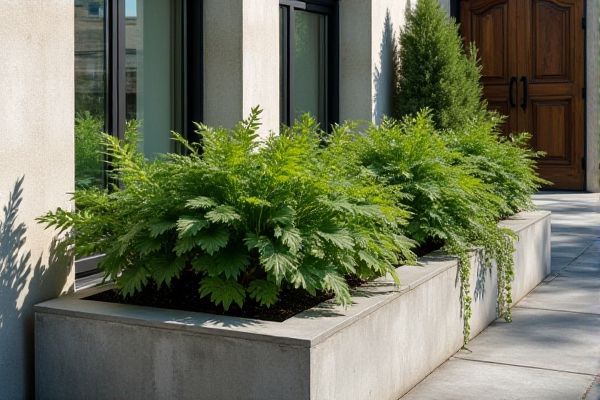
A modular planter system offers customizable, expandable options that adapt easily to different spaces and plant types, unlike a single planter which is fixed in size and design. Discover how your gardening experience can be enhanced with flexibility and versatility by reading the rest of this article.
Table of Comparison
| Feature | Modular Planter System | Single Planter |
|---|---|---|
| Design | Interlocking units for customizable layouts | Standalone, fixed size and shape |
| Flexibility | Expandable and adaptable to space | Limited to one container |
| Maintenance | Easier access through separate modules | Maintenance focused on single unit |
| Cost | Higher initial investment, scalable | Lower upfront cost |
| Plant Variety | Supports diverse plants in different modules | Limited to plants in single container |
| Space Optimization | Maximizes vertical and horizontal use | Restricted to planter footprint |
| Durability | Typically made from durable, weather-resistant materials | Varies widely by model and material |
| Assembly | Requires setup of multiple components | Ready to use out-of-the-box |
Introduction to Modular and Single Planter Systems
Modular planter systems consist of multiple interconnected units that allow for customizable and scalable gardening solutions, promoting efficient space utilization and easier maintenance. Single planter systems are standalone containers designed for individual plants, offering simplicity and portability but limited in size and adaptability. Modular systems provide greater flexibility for urban gardening and complex layouts compared to the straightforward functionality of single planters.
Core Design Differences
Modular planter systems consist of interlocking units that allow customizable configurations, enabling flexible garden layouts and scalability, while single planters are standalone containers with fixed dimensions. The core design difference lies in modular systems offering expansion and efficient use of space through connectable sections, contrasting the singular, non-expandable nature of single planters. Modular designs often include integrated watering and drainage features tailored to multiple connected units, whereas single planters rely on individual maintenance and water management.
Space Efficiency Comparison
A modular planter system maximizes space efficiency by allowing multiple connected units to fit seamlessly into various dimensions and layouts, unlike single planters that often occupy fixed, non-adjustable spaces. Modular systems enable vertical stacking or horizontal expansion, optimizing both small balconies and large garden areas. This adaptability significantly increases plant density per square foot compared to traditional single planter setups.
Flexibility and Customization
A modular planter system offers superior flexibility and customization compared to a single planter, allowing you to easily rearrange and expand your garden setup to fit various spaces and aesthetic preferences. Each module can be tailored with different plant types, soil compositions, and drainage options, enabling a personalized gardening experience. This adaptability enhances your ability to create a dynamic and functional garden environment that evolves with your needs.
Installation and Setup Process
Modular planter systems feature interlocking components that simplify installation and allow for easy customization and expansion without the need for heavy tools or professional help. Single planters require individual setup, often involving separate planting, drainage, and positioning, which can be more time-consuming and less flexible. Your choice impacts installation time and adaptability, with modular systems offering a streamlined, scalable solution for various gardening needs.
Maintenance and Upkeep Needs
A modular planter system offers easier maintenance and upkeep compared to single planters due to its customizable sections that allow targeted watering, soil replacement, and pest control. You can quickly access individual modules without disturbing the entire planting arrangement, reducing stress on plants and simplifying seasonal care. This design enhances long-term plant health and minimizes labor-intensive maintenance typically associated with single, large planters.
Aesthetic Appeal and Versatility
Modular planter systems offer enhanced aesthetic appeal through customizable configurations that adapt to various spaces and design preferences, creating visually dynamic green walls or garden layouts. Unlike single planters, modular systems provide greater versatility by allowing users to expand, rearrange, or replace individual modules to suit changing plant needs and spatial constraints. This flexibility supports diverse horticultural styles while maintaining a cohesive and modern appearance.
Cost Considerations
Modular planter systems generally have higher upfront costs due to their versatile design and customizable components, but they offer long-term savings through expandability and reuse, reducing the need for frequent replacements. Single planters typically have lower initial prices but may incur additional expenses over time as gardeners need to purchase multiple units to accommodate plant growth or garden expansion. Evaluating the cost-effectiveness depends on project scale, desired flexibility, and future gardening goals.
Suitability for Different Plants and Environments
Modular planter systems offer flexible configurations that accommodate diverse plant types and adapt well to varying environments, making them ideal for gardeners seeking tailored solutions. Single planters, while simpler, may limit plant growth due to fixed size and shape, making them less suitable for plants with extensive root systems or specific spatial requirements. Selecting the right system depends on Your space constraints and the unique needs of each plant species for optimal growth and health.
Sustainability and Eco-Friendliness
Modular planter systems enhance sustainability by enabling easy replacement and reconfiguration of individual components, reducing overall material waste compared to single planters. Their design promotes efficient water usage and supports plant health by allowing customized soil and drainage solutions for each module. Single planters often require full replacement when damaged, leading to increased resource consumption and environmental impact.
 homyna.com
homyna.com